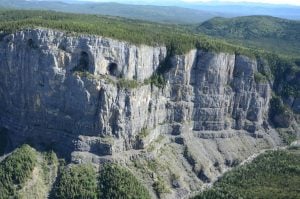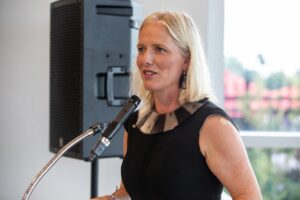
Exploration
Subterranean trailblazers
Caving: The ultimate underground sport
- 5055 words
- 21 minutes
This article is over 5 years old and may contain outdated information.
People & Culture

She’s travelled from the Siberian mountains to the Libyan deserts. But the most dangerous place she’s been is where she feels most at home — under the water.
As a professional in one of the world’s most dangerous sports, cave diver Jill Heinerth has seen parts of the planet that no one else has, diving deeper into caves than any other woman before her. While others may only see the deadly risks cave diving poses, Heinerth continues to explore underwater caverns and is often the first to lay eyes on what lies beneath the surface.
“When I look into the doorway of a cave, I see the opportunity to view something that nobody’s ever seen before, the kind of experience that nobody’s ever experienced before,” she says, adding that she then shares that experience with the world.
And that’s exactly what she did at The Royal Canadian Geographical Society’s 2014 spring speakers series on April 30. The 49-year-old thrilled the sold-out crowd at the Canada Aviation and Space Museum in Ottawa with tales of her many underwater adventures and deadly pursuits.
“We know more about space than we do our undersea world, and there’s so much for us to learn from these environments.”
As a child, Heinerth got her first taste of exploration through TV, watching Jacques Cousteau travel underwater and Neil Armstrong walk on the moon.
“I wanted to be an astronaut,” she says, “but a young girl at that time really wasn’t encouraged to follow that path. It wasn’t something that people thought was possible. But secretly, I always held that desire to become a diver. I didn’t get the opportunity to chase that dream until I was in university.”
Heinerth obtained a Bachelor of Fine Arts at York University in Toronto and had a successful career in graphic design. But at night and on weekends, she travelled to Tobermory, Ont. to scuba dive or teach others to dive.
Taking the first of many brave steps, Heinerth eventually chose to give up her career, sell her business and all her personal belongings and move to the Cayman Islands to pursue scuba diving full-time.
“I knew I needed to find a way to get out of the four walls of my office and blend my creative interests and background with my desire to be underwater,” she says.
With hard work and persistence, she was not only successful in becoming a professional scuba diver, but also conquered the roles of filmmaker, writer, underwater photographer and creator of the We Are Water project. She’s also been awarded the Sir Christopher Ondaatje Medal for Exploration.
And now, she can add RCGS speaker series presenter to that list.
Much of Heinerth’s presentation focused on her experience making Ice Island, a film chronicling her team’s exploration of caves inside an Antarctic iceberg. Originally, Heinerth was hoping to follow in the footsteps of Ernest Shackleton, who explored Antarctica 100 years ago. But as she was preparing for the journey, an iceberg the size of Jamaica calved off from Antarctica’s Ross Ice Shelf, becoming the largest iceberg in recorded history.
“When it happened, there were chills down my spine,” she says. “I knew immediately that we were going to go there and intercept this iceberg.”
So began a 60-day journey into freezing, ice-packed waters to find out what lay within the iceberg.
What Heinerth and her team found were fractures, crevasses and caves within the iceberg that allowed them to scuba dive along orange, yellow and red sea floors covered by ice archways glowing blue and white in the light. Despite the cold, inhospitable environment, the iceberg was teeming with life.
“We had thousands of these amphipods crawling around like giant cockroaches, falling off the ceiling and landing on us, crawling around and mating,” she says. “It was just a riot of life. Before that, nobody had ever seen it.” She also notes the team found a new species of killer whales near the iceberg.
But the joy of new discovery came with plenty of danger, including many near misses as the ice shifted and closed in. “I thought I was going to die when we were trapped inside the iceberg by currents and held back from getting out of the cave,” Heinerth says. (See video (left) for Heinerth’s account of the near-death experience.)
The urgent situation meant Heinerth and her crew had to forget about filming and head for the surface.
“At the time, I thought that we had failed in our mission, that we had not completed the amount and type of footage that we needed,” she says. “It hadn’t even occurred to me that the perils of diving inside the cave and our almost demise was really the story until I was on my way home.”
Despite seeing many parts of the planet almost no one else has and having several brushes with death, Heinerth still has many destinations on her bucket list that she wants to explore, including Turkey, Cuba, China and the Galapagos Islands.
“The future holds a lot more travel, a lot more exploration and a lot more sharing and documenting the fascinating world around us.”

Are you passionate about Canadian geography?
You can support Canadian Geographic in 3 ways:

Exploration
Caving: The ultimate underground sport

Exploration
2022 is the International Year of Caves and Karst. Here’s why you should care about the hidden worlds beneath our feet.

People & Culture
The story of how a critically endangered Indigenous language can be saved

People & Culture
A century after the first woman was elected to the Canadian Parliament, one of the most prominent figures in present-day politics shares her thoughts on how to amplify diverse voices in the Commons